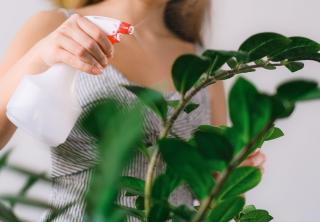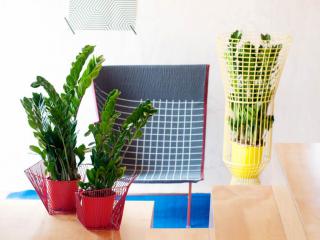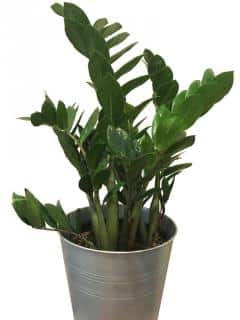

The ZZ plant’s long leaf fronds are a perfect fit for designers.
ZZ plant key facts
Name – Zamioculcas zamiifolia
Family – Araceae
Type – indoor plant, succulent
Height – 1 ½-3 ft (0.5-1 m) indoors
Propagation – cuttings, division
Exposure: well-lit, indirect – Soil: soil mix – Foliage: evergreen
Caring for it is such an easy feat it’s even been called the plant of steel or cast-iron plant. With a few minutes of attention every now and then, your ZZ plant will keep sending up shoots like a set of natural fireworks!
Below, you’ll learn all there is to know about caring for the ZZ plant as an indoor houseplant.

Here is what you should take note of:
The ZZ plant evolved in a cyclic environment: extended drought followed by flash floods.

You can replicate flash floods by dunking the ZZ plant, pot and all, in a barrel, or showering it thoroughly. To compensate for nutrient washout, either add decomposing plant materials to the dunking barrel or fertilize your ZZ with natural fermented tea (such as fermented nettle).

Creating moisture in the air around the ZZ plant will help it thrive.
Growth of your ZZ plant is directly related to exposure. A lot of indirect light will let the plant send up new shoots every month or two. On the other hand, a ZZ plant without much light will more or less stay put. But it will survive!
 Indirect light – set the plant off the side of a window instead of directly in front of it. Perhaps a light-colored wall gets a lot of reflected light, which is perfect for the ZZ plant.
Indirect light – set the plant off the side of a window instead of directly in front of it. Perhaps a light-colored wall gets a lot of reflected light, which is perfect for the ZZ plant.A good option for the ZZ plant is to move it from room to room.
Moving your ZZ plant all around the house will enhance growing and maximize your pleasure in seeing it in different places!
There are many ways to multiply your ZZ plant, and they all have one thing in common: the need for patience!
You can prepare cuttings from both leaf or stem. You can practice division when repotting.
Like a succulent, the ZZ plant can sprout new tubers and leaves from any part of the plant.

Other issues that might happen are related to potted growing: yellow leaves, stems falling over, and such problems.
Small crystals in the sap may cause rashes on skin where touched. Sensitive persons should wear gloves when performing tasks like repotting, transplanting, and dividing ZZ plants.
As a chemical, calcium oxalate crystals aren’t toxic but merely irritating. Ingesting small amounts (say, a leaf) will only result in discomfort but isn’t dangerous for cats, dogs… and children!
On the upside, these uncommon compounds actually makes the plant useful: it can purify air!
Scientists discovered that the ZZ plant removes pollutants from air. It filters and stocks toxins in its roots, stems and leaves:
>> Learn more about air-purifying houseplants
For the first two decades of being sold, only the normal ZZ plant was found. Nowadays, new ZZ plant varieties exist that are intriguing and wonderful. The two most famous are the Raven ZZ plant and the Zenzi.

New leaves are bright green, even for black varieties.
Conference centers, hotels and public building love the ZZ plant for the hype it shares, its resilience, and ease of care.
The only plant within its genus (the Araceae family), the ZZ plant was slow in becoming a commercial success. Slow growth was the main drawback since it takes years before producing a large enough plant.
If ever leaves fall off because of water stress, don’t throw them out!
Simply prick all leaflets in soil one by one with the stem down, and you’ll be growing new ZZ from scratch!